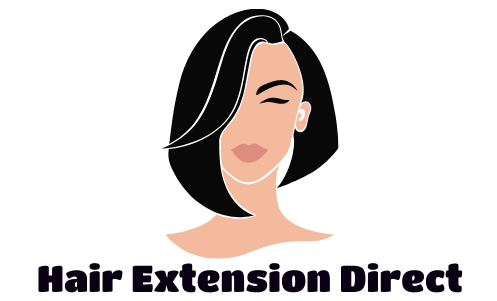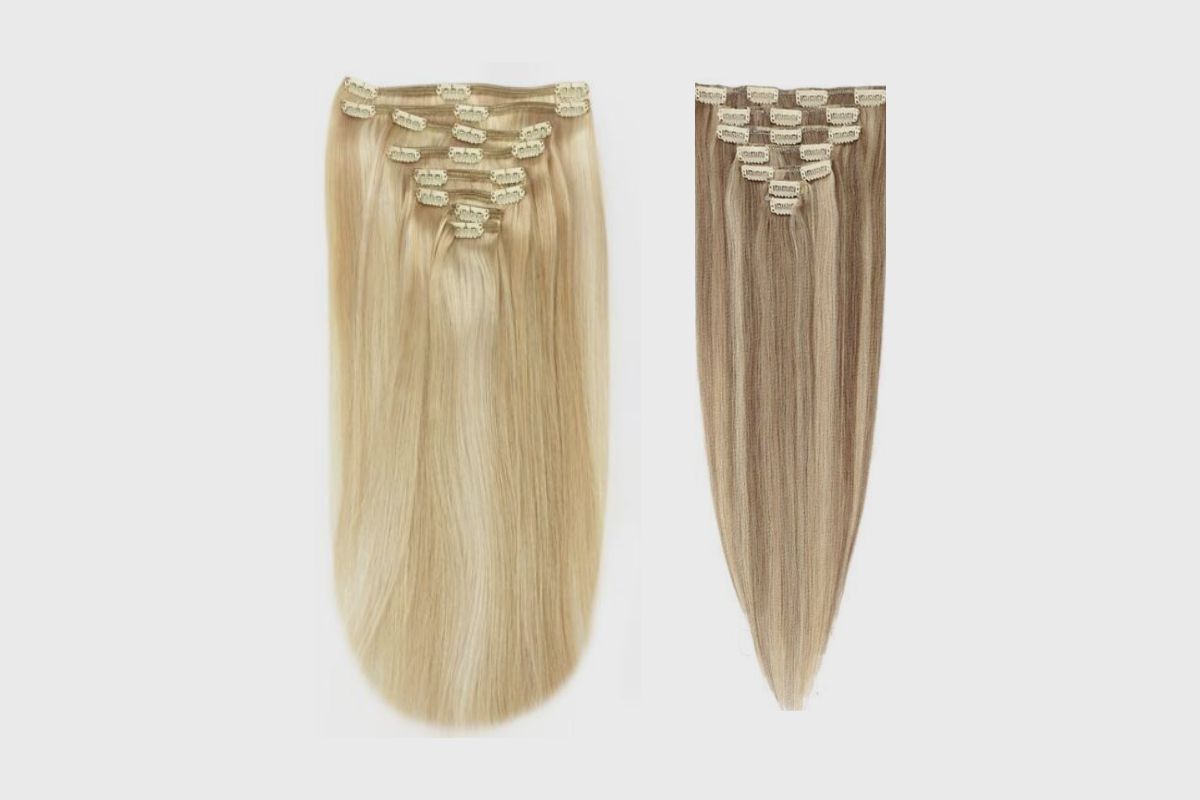Among the variety of hair extensions available, such as tape-ins, sew-ins, micro-links and fusion extensions, there are also clip-ins, which have fast become a go-to solution for people who want to enhance their hair length, hair volume, or even both.
Clip-in hair extensions allow you to change your hairstyle temporarily, and as such, you can wear them either for special events or even on a daily basis if you want to change your look without a visit to the salon.
This guide will cover everything you need to know about clip-in hair extensions, the types, benefits, application process, and so much more.
- A brief overview of hair extensions
- Focus on Clip-in Hair Extensions
- What are Clip-in Hair Extensions?
- Types of clip-in hair extensions
- Application Process
- Advantages of Clip-in Hair Extensions
- Disadvantages of Clip-in Hair Extensions
- Caring for Clip-in Hair Extensions
- How to Choose High-Quality Clip-in Hair Extensions
- Conclusion
-
FAQs – Frequently Asked Questions About the Guide to Clip-in Hair Extensions
- Q: What are clip-in hair extensions?
- Q: How are clip-in hair extensions different from other types of hair extensions?
- Q: What are the advantages of using clip-in hair extensions?
- Q: What are the disadvantages of clip-in hair extensions?
- Q: Are clip-in hair extensions made from real human hair or synthetic materials?
- Q: What lengths do clip-in hair extensions come in?
- Q: What textures do clip-in hair extensions come in?
- Q: How are clip-in hair extensions attached?
- Q: How should I care for my clip-in hair extensions?
- Q: Can I heat style my synthetic clip-in hair extensions?
- Q: What are some benefits of using human hair extensions over synthetic ones?
- Q: How can I achieve a seamless look with clip-in hair extensions?
- Q: How do I prevent clip-in extensions from slipping or sliding?
- Q: Can I wash my synthetic hair extensions?
- Q: How can I properly store my clip-in hair extensions?
- Q: How do I choose high-quality clip-in hair extensions?
- Q: Are clip-in hair extensions comfortable to wear?
- Q: Can I style clip-in hair extensions?
- Q: What are some common issues with clip-in hair extensions?
- Q: How long do clip-in hair extensions last?
- Image Gallery – Guide to Clip-in Hair Extensions
Related Posts to read:
A brief overview of hair extensions
Hair extensions have gained popularity in recent times for several reasons, especially their convenience, versatility, and accessibility.
They come in a variety of lengths, colours, and textures to match your natural hair. In fact, most times, you can leave people wondering whether it is your natural hair or not. These extensions can be made from synthetic fibres or real human hair.
Regardless of the type of hair extension you choose, you must keep in mind that proper care and maintenance are necessary to ensure the longevity and condition of hair extensions.
Getting professional guidance on which extension type would suit you best, as well as their installation process, can also be very helpful in maintaining your natural hair as well as the extension you choose to buy.
Focus on Clip-in Hair Extensions
Clip-in hair extensions have quickly become popular for many users due to their ease of use. Unlike other hair extensions that require professional installation due to their technical process, attaching clip-ins can be done in a simple DIY process.
So there’s no need to visit a salon; you can attach and detach clip-ins by yourself.
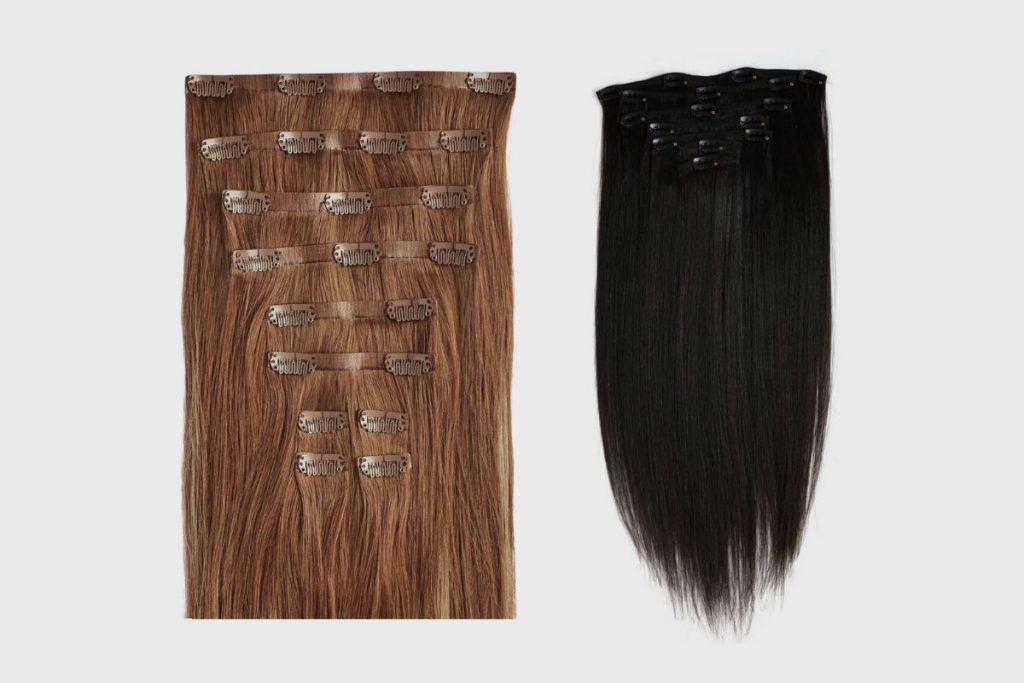
What are Clip-in Hair Extensions?
Clip-in hair extensions are called clip-ins because they can easily be clipped in and removed from your natural hair. They add length and volume to your hair and are considered semi-permanent.
Clip-in hair extensions are made up of individual hair wefts that have small clips sewn onto them. These clips are designed to securely attach the extensions to your own hair, creating a seamless blend.
These extensions have gained popularity from their ease of use, as they don’t require glue, heat, fusion, braids or clamps like other types of hair extensions. All you have to do is open the clip, attach the clip hair extensions and press the clip closed, and voilà!
Some key features of clip-in hair extensions are versatility, low maintenance, ease of use, flexibility, and reusability, amongst many others.
Clip-in hair extensions are available in a variety of lengths, colours, textures, and styles to suit different preferences. They can be made from either human hair or synthetic materials.
Human hair extensions offer the most natural look and feel, as they can be styled and treated just like your own hair. Synthetic hair extensions, on the other hand, are pre-styled and can’t withstand heat styling.
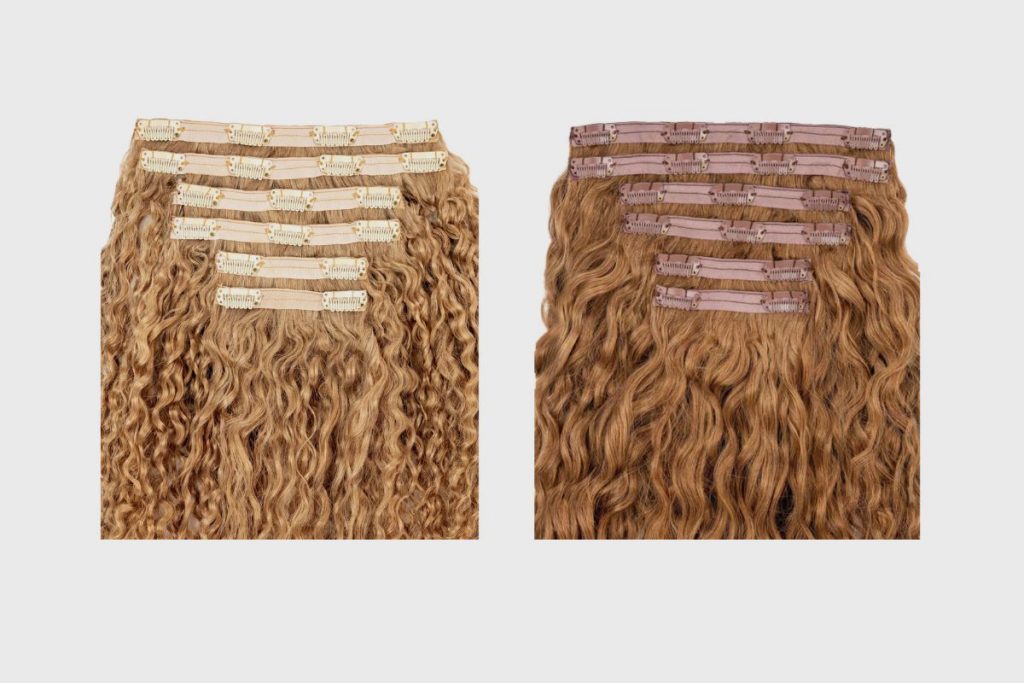
Benefits of clip-in hair extensions
Clip-in extensions offer a wide range of benefits to users; listed below are some:
- Ease of use: Clip-ins can be easily attached and detached. Since they come with small clips attached to the wefts, you can securely attach them to your natural hair. And they can be easily removed by unclipping the clips, making them a convenient option for temporary use.
- Versatility: Asides from their ease of use, clip-in hair extensions are versatile. They come in different lengths, colours, textures, and styles to allow you to try out different looks and choose your desired style.
- Comfortable and convenient: Clip-in hair extensions offer a comfortable and convenient way to enhance your look. They are designed to avoid pulling on your natural hair, minimizing the risk of damage. Using extensions, you can add volume and length without having to worry about your hair’s health.
- Cost-effective: Compared with other types of hair extensions, clip-ins are more affordable. Investing in high-quality clip-in hair extensions would ease your worries about damage, given their durability and reusability with proper maintenance. Also, you do not have to worry about installation costs because you can have it attached and detached yourself.
- Low maintenance: Unlike other types of hair extensions, clip-in extensions do not require extensive maintenance. Provided that you follow the necessary care instructions, you can save both time and money that would otherwise be spent on salon visits for maintenance.
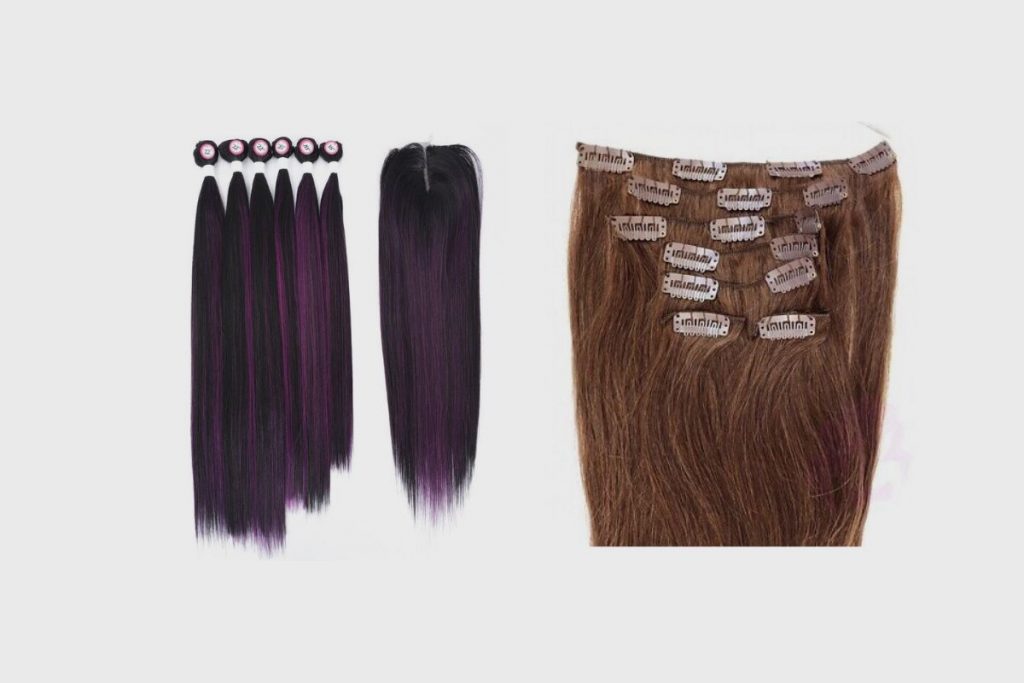
Types of clip-in hair extensions
1. Synthetic hair: This type of clip-in hair extension is made from artificial fibres that take the appearance of natural hair. They are pre-styled and often come in a wide range of colours and textures.
Although synthetic extensions are cheaper than human hair extensions, they are not as durable and can not withstand heat styling.
Therefore, if you plan on using heat styling tools frequently, it is recommended that you invest in human hair extensions, which are more resilient.
However, synthetic extensions can be a great option if you are on a budget and do not require heat styling.
2. Human hair: From the name, you can deduce that human hair clip-in extensions are made from real human hair, offering the most natural look and feel. These extensions can be styled, dyed, and treated just like your own hair, providing versatility and seamless blending with your natural hair.
Human hair extensions are available in various grades, and as expected, the higher the quality, the higher the price. However, these extensions are considered as a worthy investment because they provide durability, can withstand heat styling and effortlessly blend with your own hair texture.
Clip-in hair extension lengths and textures
Having a variety of choices is valued by many, which is why clip-in hair extensions come in different lengths and textures to cater to diverse individual preferences.
The availability of various options in terms of lengths and textures means there is something for everyone. Note that the choice of length and texture depends on your personal preference and desired hairstyle.
For lengths, you can find clip-in hair extensions in:
- Short length: usually 8–14 inches
- Medium length: 16–22 inches
- Long length: 22-30 inches or more
There are also different textures available; listed below are some examples:
- Straight which is suitable for straight hair textures
- Curly, which takes the form of loose curls, spiral curls, or kinky curls.
- Wavy which could be body wave or deep wave
Application Process
As explained earlier, applying your clip-ins to your hair is a straightforward and easy process. Just take note of the following for a seamless result:
Tools and accessories needed:
- Hairbrush or a wide toothcomb
- Tail comb
- Bobby pins
- Hair spray
- Hair clips.
Preparing your natural hair
- Wash and dry your natural hair
- Brush and comb to ensure it is tangle-free
- You can apply hair spray or hair oil to make your hair shine
Sectioning and placement
- Using a tail comb, section your hair depending on your choice of style
- You can now use your clips to keep the rest of your hair in place while you work your way through
Attaching the clip-in extensions
- Gently open the clips and attach them to the roots of your hair until they are in your desired position. To prevent damage to your natural hair, ensure that the clips are not too tight.
- When the clips are securely in place, snap the clips shut
- Repeat this process till you achieve your desired result
Blending and Styling
- Now that all the clip-in extensions are securely attached, comb or brush through the hair to blend with the extensions
- You can now style your hair as desired using heat styling tools or any accessory of your choice
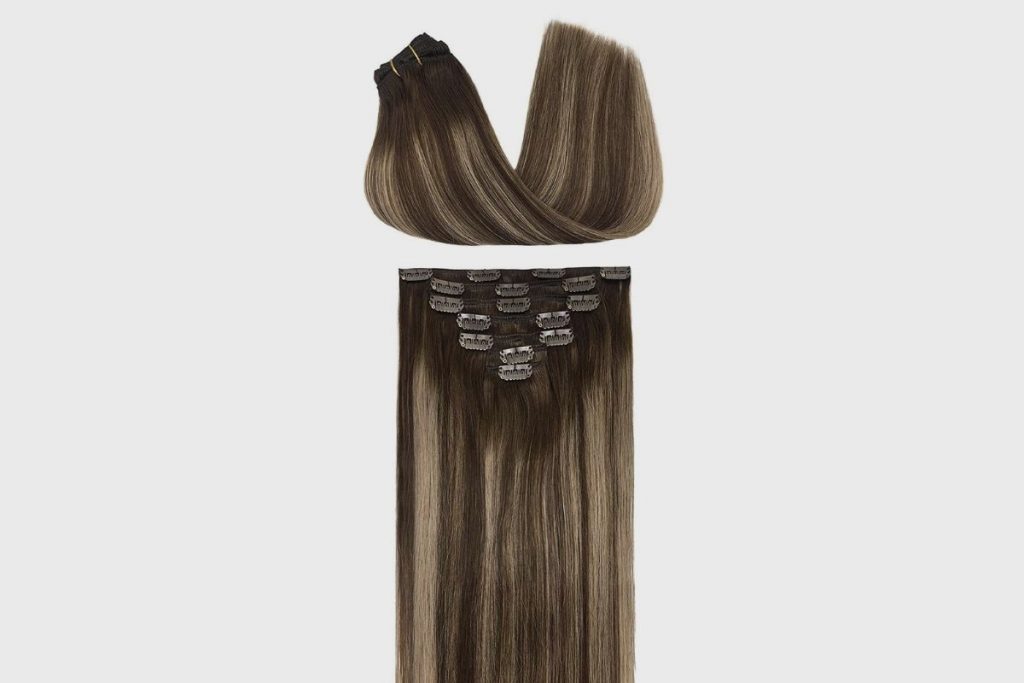
Advantages of Clip-in Hair Extensions
- Easy to apply and remove
- Non-damaging to natural hair
- Cost-effective
- Versatility in styles
- Temporary and commitment-free.
Disadvantages of Clip-in Hair Extensions
- Limited style options compared to other hair extension types
- It may be visible if not applied correctly
- Not suitable for extremely fine or thin hair
- Synthetic clip-ins may not blend well with natural hair
Caring for Clip-in Hair Extensions
Caring for your clip-in hair extensions depends on the type you own, whether human hair or synthetic. The caring technique for each kind of hair varies, but it is generally recommended that you avoid washing synthetic hair extensions. Listed below are some of the ways to care for your clip-in hair extensions:
Washing and conditioning
- Gently detangle the extensions before washing to minimize tangling.
- Use a mild shampoo and conditioner specifically designed for extensions.
- Avoid applying conditioner directly on the clips to prevent slippage.
- Rinse the extensions thoroughly and gently squeeze out excess water. Be careful when squeezing out water, and avoid twisting or wringing the extensions.
- Allow the extensions to air dry, or use a hairdryer in a low heat setting.
Brushing and detangling
- Use a wide-tooth comb to detangle the extensions, starting from the ends and working your way up.
- Hold the hair at the roots when brushing to prevent unnecessary tension on the clips.
- Avoid brushing excessively to minimize the shedding of hair extensions.
Heat styling precautions
- Use heat protectant spray before using any heat-styling tools.
- Set the tools to a low heat setting to prevent damage.
- Avoid applying direct heat to the clips or bonds of the extensions.
- To preserve the quality of the extensions, do not frequently use heat styling.
Proper storage
- Ensure that you store your clip-in extensions in a cool, dry place when not in use.
- Keep them away from direct sunlight or humid environments to maintain their condition.
- To prevent tangling, use a designated storage bag or container
- Avoid storing your clip-in extensions when they are wet. Only dried hair should be stored.
Tips for Blending and Styling Clip-in Hair Extensions
To achieve a classy and seamless look with your clip-in hair extensions, consider the following tips:
Colour-matching: Always opt for hair extensions that match with your natural hair for seamless blending. If you want to try something different, you can temporarily dye your hair to blend the extensions with your hair colour.
Layering and cutting: You should consider layering the hair extensions for an easy blend with your natural hair, and for a more personalized look, you can have the extensions trimmed.
Curling and straightening: Depending on your preferred style, whether curly or straight, you can use heat styling tools like straighteners, curling irons, hot air brushes or rollers to achieve a smooth blend with your hair. Just ensure that whichever tool you choose to use is set at a low temperature to avoid damaging the extensions.
Creating updos and braids: You can style the clip-in extensions into updos and braided hairstyles to add volume, length, or texture. Secure your extensions with bobby pins or hair elastics to ensure they stay in place.
Troubleshooting Common Clip-in Hair Extension Issues
Listed below are some troubleshooting tips to help you overcome common challenges and achieve the desired results
Slipping or sliding clips
To prevent slipping or sliding clips, make sure your natural hair is completely free from hair products. Attach the clips to smaller sections of hair and secure them close to the scalp. You can use bobby pins or hair pins to offer extra support to keep the extensions in place.
Uneven or visible extensions
If you want a seamless blend, you have to ensure that the extensions are properly layered and blended with your natural hair. Trim them if need be to match the length and layers of your own hair.
Now, check for uneven distribution and adjust the clips accordingly. By styling your hair in loose waves or curls, it blends into your hair easily for a more natural appearance.
Difficulty blending extensions with natural hair
To enhance blending, apply a light styling product like texturizing spray to both your natural hair and the extensions. Then use heat styling tools such as curling irons or straighteners to style both your hair and the extensions for a consistent texture.
You might also want to consider using hair accessories like headbands, scarves, or hats to conceal any blending issues and add a stylish touch to your overall look.
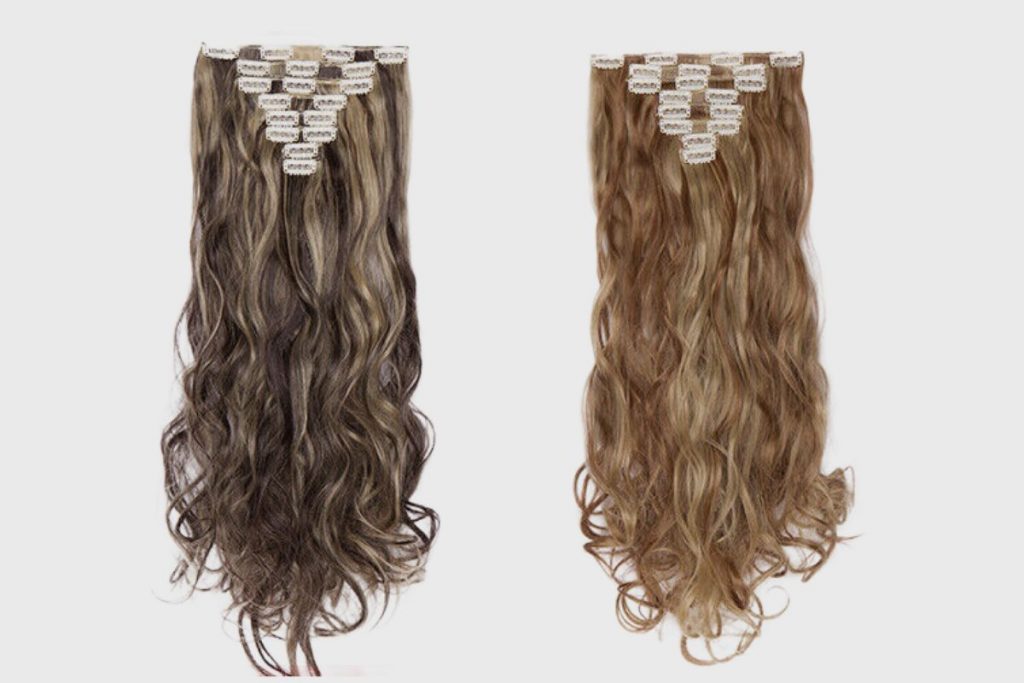
How to Choose High-Quality Clip-in Hair Extensions
When it comes to selecting clip-in hair extensions, it is important to invest in high-quality options that do not just blend seamlessly with your natural hair but also offer durability. Take note of the following:
Identifying Human hair vs synthetic hair
Although more expensive, human hair extensions have a more natural texture, and you can tell simply by touching them. These hair extensions can withstand styling with heat tools, shed less, and are tangle-free.
Synthetic hair extensions, on the other hand, are more affordable, prone to tangling and shedding, and have no resistance to heat.
Evaluating hair extension brands
In the market today, you will find different hair extension brands, but you have to be careful when making a choice. Do your research and choose brands that are renowned for high-quality hair extensions.
Considering hair extension weight and density
Ensuring that your clip-in extensions are lightweight is crucial to avoid them from slipping or becoming loose. If the extensions are too heavy for your natural hair, they can exert pressure on your hair, leading to loose clips and potential damage to your natural hair.
Therefore, it is important to choose clip-in extensions that match the weight and density of your natural hair for a seamless blend to maintain a secure and comfortable fit.
Conclusion
In conclusion, clip-in hair extensions are a convenient and versatile option for everyone who wants to enhance their hair length and volume. These extensions offer numerous benefits, such as ease of use, versatility in styles, cost-effectiveness, and low maintenance.
When you choose high-quality clip-in hair extensions, you can be sure of a seamless blend with your natural hair.
The versatility of these extensions is what makes it the most popular type of hair extensions.
They provide instant length and volume, are easy to attach and detach, offer a temporary transformation, seamlessly blend with your natural hair, and allow for a wide range of style options.
By following these guidelines, you can choose high-quality clip-in hair extensions that enhance your natural beauty and provide a temporary transformation whenever desired.
FAQs – Frequently Asked Questions About the Guide to Clip-in Hair Extensions
Q: What are clip-in hair extensions?
A: Clip-in hair extensions are hair wefts that have small clips sewn onto them. They are easy to use and don’t require professional installation. They can be attached or detached from your natural hair, adding length and volume.
Q: How are clip-in hair extensions different from other types of hair extensions?
A: Unlike other hair extensions that require professional installation, attaching clip-ins can be done in a simple DIY process. They don’t require glue, heat, fusion, braids, or clamps like other types of hair extensions.
Q: What are the advantages of using clip-in hair extensions?
A: Clip-in hair extensions offer many advantages, such as ease of use, low maintenance, flexibility, reusability, and cost-effectiveness. They can also provide instant length and volume to your hair and can be easily removed when not needed.
Q: What are the disadvantages of clip-in hair extensions?
A: The limitations of clip-in extensions include limited style options compared to other types, potential visibility if not applied correctly, unsuitability for extremely fine or thin hair, and possible poor blending with natural hair, especially in the case of synthetic clip-ins.
Q: Are clip-in hair extensions made from real human hair or synthetic materials?
A: Clip-in hair extensions can be made from either real human hair or synthetic materials. Human hair extensions provide a more natural look and can be styled like your own hair, while synthetic hair extensions are pre-styled and cannot withstand heat styling.
Q: What lengths do clip-in hair extensions come in?
A: Clip-in hair extensions come in various lengths, including short lengths (8–14 inches), medium lengths (16–22 inches), and long lengths (22-30 inches or more).
Q: What textures do clip-in hair extensions come in?
A: Clip-in hair extensions are available in different textures, including straight, curly (loose curls, spiral curls, or kinky curls), and wavy (body wave or deep wave).
Q: How are clip-in hair extensions attached?
A: Clip-in hair extensions are easy to attach. You open the clip, attach it to your own hair, and press the clip closed. They can be done at home without a visit to the salon.
Q: How should I care for my clip-in hair extensions?
A: Caring for your clip-in hair extensions involves gentle washing and conditioning, brushing, detangling, heat styling precautions, and proper storage. It’s crucial to follow the care instructions to ensure the longevity of your extensions.
Q: Can I heat style my synthetic clip-in hair extensions?
A: Synthetic hair extensions cannot withstand heat styling, unlike human hair extensions. Therefore, it’s recommended to avoid using heat styling tools on synthetic clip-ins.
Q: What are some benefits of using human hair extensions over synthetic ones?
A: Human hair extensions provide a more natural look and feel, can be styled and treated just like your own hair, and can withstand heat styling, making them more versatile than synthetic extensions.
Q: How can I achieve a seamless look with clip-in hair extensions?
A: To achieve a seamless look, it’s crucial to choose extensions that match your natural hair colour; consider layering or cutting the extensions for an easy blend, use heat styling tools to achieve a consistent texture, and you can even style them into updos and braided hairstyles.
Q: How do I prevent clip-in extensions from slipping or sliding?
A: To prevent slipping or sliding, attach the clips to smaller sections of hair and secure them close to the scalp. You can also use bobby pins or hair pins for extra support to keep the extensions in place.
Q: Can I wash my synthetic hair extensions?
A: It is generally recommended to avoid washing synthetic hair extensions as they can’t withstand moisture. However, human hair extensions can be gently washed with mild shampoo and conditioner.
Q: How can I properly store my clip-in hair extensions?
A: You should store your clip-in extensions in a cool, dry place, away from direct sunlight or humid environments. Use a designated storage bag or container and make sure the hair is completely dry before storing.
Q: How do I choose high-quality clip-in hair extensions?
A: When choosing clip-in hair extensions, look for brands known for high quality, ensure the extensions match the weight and density of your natural hair, and distinguish between human hair and synthetic hair, as human hair offers a more natural look and feel.
Q: Are clip-in hair extensions comfortable to wear?
A: Yes, clip-in hair extensions are designed to avoid pulling on your natural hair, minimizing the risk of damage, and making them comfortable to wear.
Q: Can I style clip-in hair extensions?
A: Yes, clip-in hair extensions are versatile and allow for a wide range of style options. You can style them as you would your natural hair, provided they are made from human hair.
Q: What are some common issues with clip-in hair extensions?
A: Some common issues include slipping or sliding clips, uneven or visible extensions, and difficulty blending extensions with natural hair. However, these issues can be managed with the correct application and proper care.
Q: How long do clip-in hair extensions last?
A: The lifespan of clip-in hair extensions depends on how well you take care of them and how often you use them. High-quality human hair extensions can last up to a year or longer with proper care.
Image Gallery – Guide to Clip-in Hair Extensions





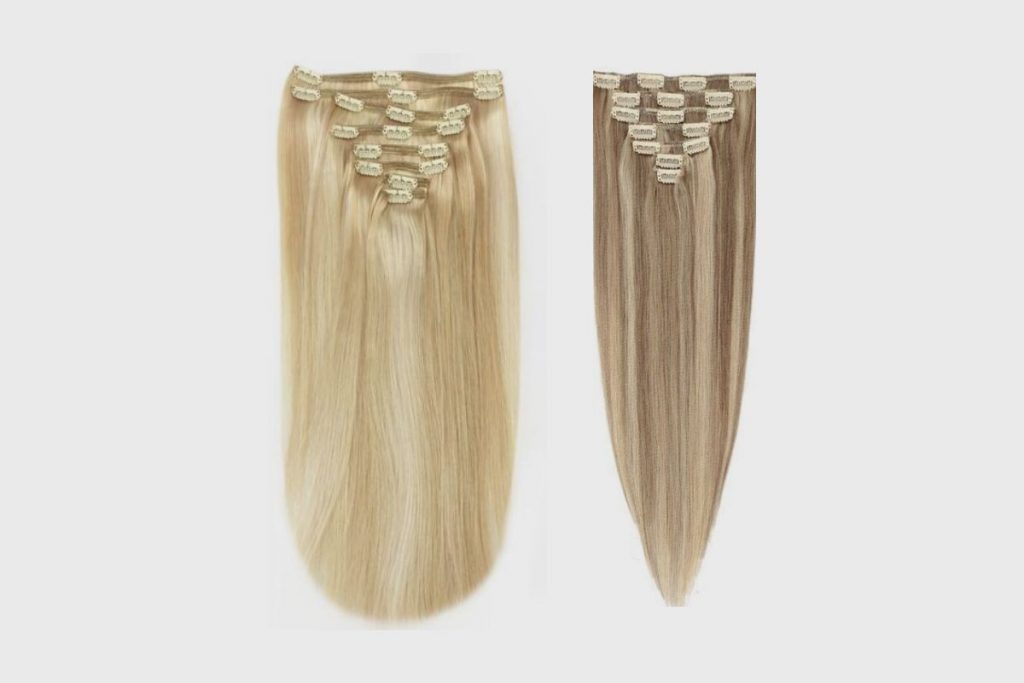
Related Posts to Read:
References:
- About Hair Extension (Link).
